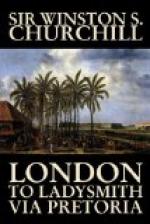At length all was over. The last dust-brown battalion had passed away and the roadway was again clear. Yet the ceremony was incomplete. Before the staff could ride away the Mayor of Ladysmith advanced and requested Sir George White to receive an address which the townspeople had prepared and were anxious to present to him. The General dismounted from his horse, and standing on the steps of the Town Hall, in the midst of the inhabitants whom he had ruled so rigorously during the hard months of the siege, listened while their Town Clerk read their earnest grateful thanks to him for saving their town from the hands of the enemy. The General replied briefly, complimented them on their behaviour during the siege, thanked them for the way in which they had borne their many hardships and submitted to the severe restrictions which the circumstances of war had brought on them, and rejoiced with them that they had been enabled by their devotion and by the bravery of the soldiers to keep the Queen’s flag flying over Ladysmith. And then everybody cheered everybody else, and so, very tired and very happy, we all went home to our belated luncheons.
Walking through the streets it was difficult to see many signs of the bombardment. The tower of the Town Hall was smashed and chipped, several houses showed large holes in their walls, and heaps of broken brickwork lay here and there. But on the whole the impression produced was one of surprise that the Boers had done so little damage with the sixteen thousand shells they had fired during the siege.
On entering the houses, however, the effect was more apparent. In one the floor was ripped up, in another the daylight gleamed through the corrugated iron roof, and in some houses the inner walls had been completely destroyed, and only heaps of rubbish lay on the floor.
The fortifications which the troops had built, though of a very strong and effective character, were neither imposing nor conspicuous; indeed, being composed of heaps of stone they were visible only as dark lines on the rugged kopjes, and if the fame of the town were to depend on relics of the war it would not long survive the siege.
But memories dwell among the tin houses and on the stony hills that will keep the name of Ladysmith fresh and full of meaning in the hearts of our countrymen. Every trench, every mound has its own tale to tell, some of them sad, but not one shameful. Here and there, scattered through the scrub by the river or on the hills of red stones almost red hot in the sun blaze, rise the wooden crosses which mark the graves of British soldiers. Near the iron bridge a considerable granite pyramid records the spot where Dick Cunyngham, colonel of the Gordons—what prouder office could a man hold?—fell mortally wounded on the 6th of January. Another monument is being built on Waggon Hill to commemorate the brave men of the Imperial Light Horse who lost their lives but saved the day. The place is also marked where the noble Ava fell.




